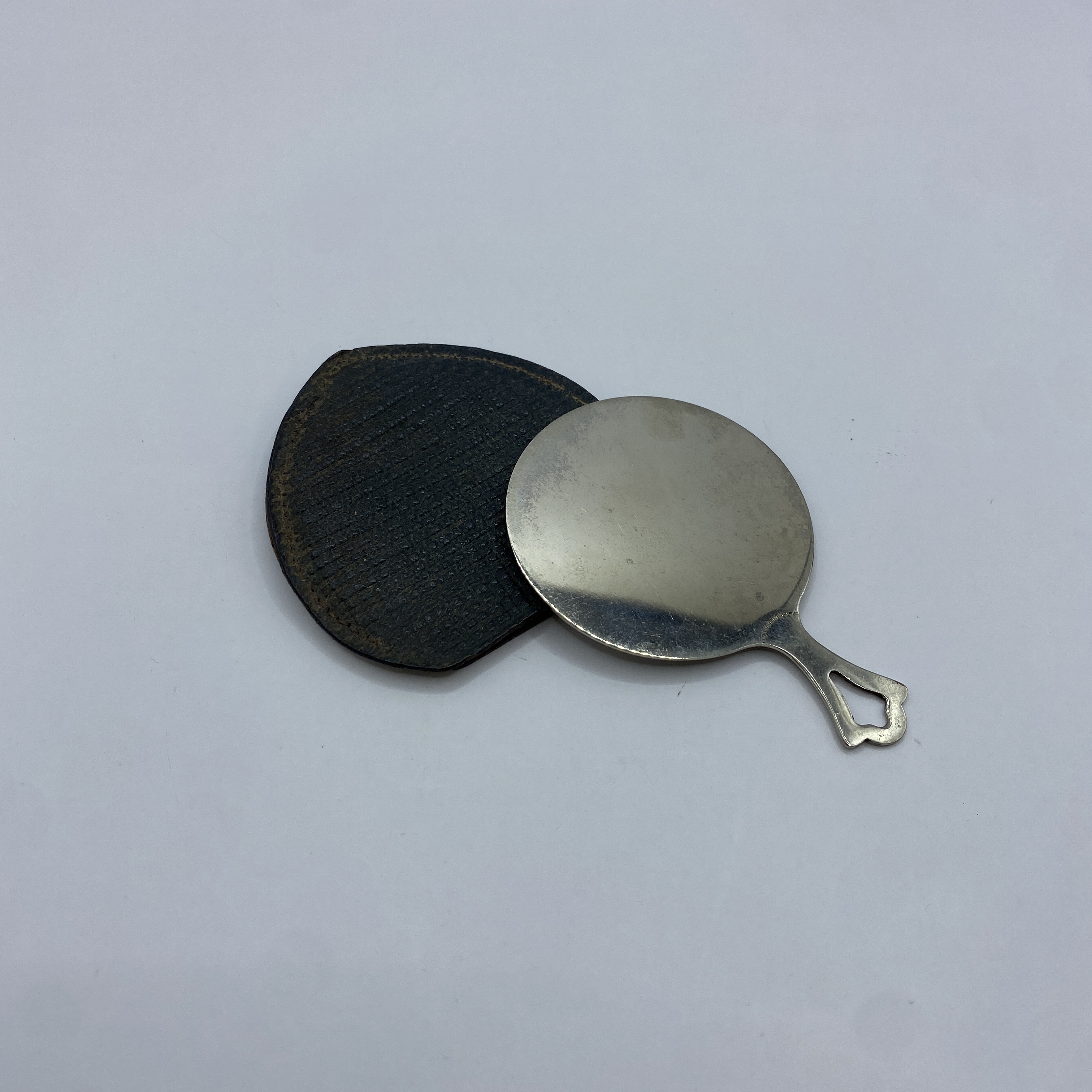Description: This coroner’s mirror was a device used in the 19th and early 20th century as a diagnostic tool by physicians to determine whether a patient was dead. Though it was commonly used in the field of medicine, the coroner’s mirror was a notoriously unreliable instrument and later fell out of practice. Death determination has a rich history consisting of its beginning in 1564 when Andreas Vesalius, commonly known as the father of modern anatomy, was observed conducting a public autopsy on a patient who was, unknown to Vesalius, still living. After this incident, a new requirement arose within the field of medicine that a physician must examine a patient and officially pronounce their death before an autopsy may be performed. However, with this vague requirement of death determination, physicians over the years created many different techniques of examining a patient’s corpse. One such technique included an anatomist by the name of Jacob Winslow in 1732 suggesting that a group of women should gather around the corpse to wail and scream with the thought that any still-living patient would become overwhelmed and immediately become conscious. An additional method of death determination consisted of physicians attaching a bell to the toe of a patient who they presumed was dead. If the patient awoke, the bell would then ring signifying that they were alive which is from where the phrase, “saved by the bell,” derives.
Origin: Circa Early 20th Century; France

90 Comments
http://terios2.ru/forums/index.php?autocom=gallery&req=si&img=4549
https://vitz.ru/forums/index.php?autocom=gallery&req=si&img=4820
http://wish-club.ru/forums/index.php?autocom=gallery&req=si&img=5343
https://mazda-demio.ru/forums/index.php?autocom=gallery&req=si&img=6448
http://wish-club.ru/forums/index.php?autocom=gallery&req=si&img=5327
https://hrv-club.ru/forums/index.php?autocom=gallery&req=si&img=6982
https://mazda-demio.ru/forums/index.php?autocom=gallery&req=si&img=6561
https://vitz.ru/forums/index.php?autocom=gallery&req=si&img=5034
https://vitz.ru/forums/index.php?autocom=gallery&req=si&img=4877
https://hrv-club.ru/forums/index.php?autocom=gallery&req=si&img=6955
https://myteana.ru/forums/index.php?autocom=gallery&req=si&img=6693
https://honda-fit.ru/forums/index.php?autocom=gallery&req=si&img=7110
https://myteana.ru/forums/index.php?autocom=gallery&req=si&img=6668
https://hrv-club.ru/forums/index.php?autocom=gallery&req=si&img=6945
http://toyota-porte.ru/forums/index.php?autocom=gallery&req=si&img=3268
https://mazda-demio.ru/forums/index.php?autocom=gallery&req=si&img=6623
http://wish-club.ru/forums/index.php?autocom=gallery&req=si&img=5517
https://mazda-demio.ru/forums/index.php?autocom=gallery&req=si&img=6342
https://mazda-demio.ru/forums/index.php?autocom=gallery&req=si&img=6338
http://wish-club.ru/forums/index.php?autocom=gallery&req=si&img=5510
http://terios2.ru/forums/index.php?autocom=gallery&req=si&img=4846
http://toyota-porte.ru/forums/index.php?autocom=gallery&req=si&img=3404
http://passo.su/forums/index.php?autocom=gallery&req=si&img=4159
https://cr-v.su/forums/index.php?autocom=gallery&req=si&img=4021
https://cr-v.su/forums/index.php?autocom=gallery&req=si&img=4015
http://toyota-porte.ru/forums/index.php?autocom=gallery&req=si&img=3232
http://toyota-porte.ru/forums/index.php?autocom=gallery&req=si&img=3245
Моя Мишель, Баста – Не поняла скачать mp3 и слушать онлайн бесплатно https://shorturl.fm/UMTUp
Демарин Игорь – Два Крыла ( 2002 ) скачать песню и слушать онлайн https://shorturl.fm/DbtII
Юлия Савичева – Любовь найдёт скачать песню на телефон и слушать бесплатно https://shorturl.fm/scOPT
Дима Билан – Молния скачать и слушать песню https://shorturl.fm/tfu7w
MACAN – Бенз скачать песню бесплатно в mp3 и слушать онлайн https://shorturl.fm/skuT0
Денис Леонов – Химия скачать и слушать онлайн https://shorturl.fm/z6BxF
Face2face – В Объятьях Ночи (Ivan Art Remix) скачать и слушать песню бесплатно https://shorturl.fm/koQjz
Natan feat. Гусейн Гасанов – Выбирай скачать mp3 и слушать онлайн https://shorturl.fm/4xhxh
Ани Лорак – Я Останусь С Тобой скачать и слушать песню https://shorturl.fm/ac6TG
Jony – Мир Сошёл С Ума скачать песню в mp3 и слушать онлайн https://shorturl.fm/fmUd1
http://wish-club.ru/forums/index.php?autocom=gallery&req=si&img=5451
http://toyota-porte.ru/forums/index.php?autocom=gallery&req=si&img=3371
http://wish-club.ru/forums/index.php?autocom=gallery&req=si&img=5244
http://wish-club.ru/forums/index.php?autocom=gallery&req=si&img=5249
https://hrv-club.ru/forums/index.php?autocom=gallery&req=si&img=6896
http://wish-club.ru/forums/index.php?autocom=gallery&req=si&img=5335
Rory – Ты скачать и слушать онлайн https://shorturl.fm/6ymks
JUSTMEET – Ночь скачать и слушать песню бесплатно https://shorturl.fm/PbyYu
Katerina Fetisova – Идеальный скачать mp3 и слушать бесплатно https://shorturl.fm/KDcEM
Davidchi feat. Flake – Макияж скачать mp3 и слушать бесплатно https://shorturl.fm/LMXmI
ВИА «Магаданцы» и ВИА «Парус» – Бабье Лето скачать mp3 и слушать бесплатно https://shorturl.fm/EEfPX
Esco, Baga – Она та дама скачать mp3 и слушать онлайн бесплатно https://shorturl.fm/YhK8P
Тайпан Feat. & Nazami – Как Тебя Найти скачать песню на телефон и слушать бесплатно https://shorturl.fm/IsCup
https://vitz.ru/forums/index.php?autocom=gallery&req=si&img=4805
https://honda-fit.ru/forums/index.php?autocom=gallery&req=si&img=7284
https://mazda-demio.ru/forums/index.php?autocom=gallery&req=si&img=6546
https://vitz.ru/forums/index.php?autocom=gallery&req=si&img=5070
https://hrv-club.ru/forums/index.php?autocom=gallery&req=si&img=6972
https://honda-fit.ru/forums/index.php?autocom=gallery&req=si&img=7278
Теплосиняя – Я В Тебя Влюблена (Arcaime Remix) скачать и слушать песню https://shorturl.fm/OvGtq
Элени – Мирабо скачать бесплатно и слушать онлайн https://shorturl.fm/19yFr
Конец Фильма – Последняя Ночь На Земле скачать и слушать песню https://shorturl.fm/Oj5Gw
Султан Лагучев – Любовь-Беда скачать и слушать песню бесплатно https://shorturl.fm/dymGY
Nechaev Feat. & Рефлекс – Первый Раз (Salandir Remix) скачать бесплатно mp3 и слушать онлайн https://shorturl.fm/A5y9s
Егор Ермолаев – 120 скачать песню и слушать бесплатно https://shorturl.fm/TrIWi
Григорий Герасимов – Белые Розы скачать бесплатно mp3 и слушать онлайн https://shorturl.fm/2cVaA
Комбинация – Вишневая девятка (Voxi Remix Extended) скачать песню в mp3 и слушать онлайн https://shorturl.fm/yRmSx
Touchy – Барселона скачать песню и слушать онлайн
https://allmp3.pro/2864-touchy-barselona.html
DREDD feat. GMS & This Blind – Новый год скачать песню и слушать онлайн
https://allmp3.pro/2856-dredd-feat-gms-this-blind-novyj-god.html
Михаил Грицкан – Дай ду Дай скачать песню и слушать онлайн
https://allmp3.pro/2663-mihail-grickan-daj-du-daj.html
Reflex – Дальний Свет ( 2001 ) скачать песню и слушать онлайн
https://allmp3.pro/2470-reflex-dalnij-svet-2001.html
Мечта – Не Уходи ( 2014 ) скачать песню и слушать онлайн
https://allmp3.pro/2488-mechta-ne-uhodi-2014.html
Натали – Первый луч скачать песню и слушать онлайн
https://allmp3.pro/3292-natali-pervyj-luch.html
Mili – Мы С Тобой скачать песню и слушать онлайн
https://allmp3.pro/3317-mili-my-s-toboj.html
Юлия HOLOD – Плохо себя вести скачать песню и слушать онлайн
https://allmp3.pro/3202-julija-holod-ploho-sebja-vesti.html
Психоаналитик и психоаналитический психотерапевт Консультация может проходить в удобном для вас формате 339
Khám phá sòng bạc xin88 com với hàng trăm trò chơi đỉnh cao kịch trần, dealer xinh đẹp ngất ngây, cược siêu đã luôn. Nạp rút nhanh nha, bảo mật tuyệt đối nữa – trải nghiệm ngay hôm nay đi mà!
levitra ireland levitra wirkungsdauer levitra headache
sans ordonnance kamagra en montreal
kamagra livraison samedi livraison
Buy enclomiphene from usa without a perscription
how to buy enclomiphene no prescription needed
purchase androxal price generic
buy androxal online japan
how to buy dutasteride cheap with fast shipping
purchase dutasteride buy san francisco
cheap flexeril cyclobenzaprine cheap uk
how to buy flexeril cyclobenzaprine generic overnight delivery
get fildena purchase online from india
cheap fildena canada how to buy
get gabapentin generic medications
gabapentin chicago where to buy
how to buy itraconazole uk cheap purchase buy
online order itraconazole price by pharmacy
discount staxyn buy japan
how to buy staxyn generic ireland
buy avodart cost per tablet
how to order avodart generic tablets
get rifaximin generic buy online
cheapest buy rifaximin cheap no prescription
discount xifaxan buy online no prescription
purchase xifaxan generic low price
je kamagra u přepážky v německu
kamagra singapore koupit
**mind vault**
mind vault is a premium cognitive support formula created for adults 45+. It’s thoughtfully designed to help maintain clear thinking
**breathe**
breathe is a plant-powered tincture crafted to promote lung performance and enhance your breathing quality.